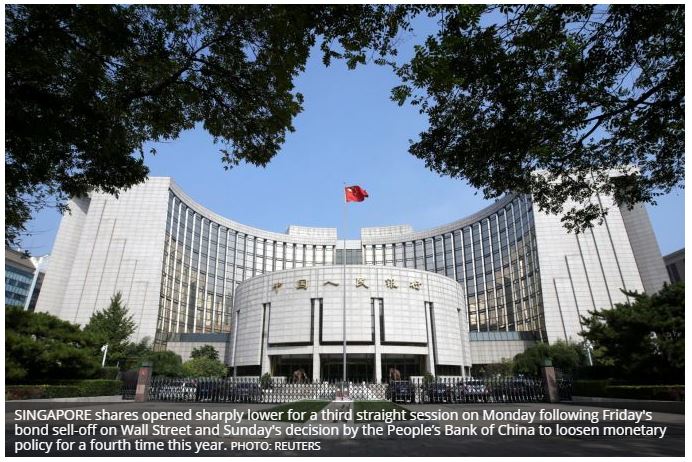Worries about trade, rates continue to pummel Asian markets
SINGAPORE shares opened sharply lower for a third straight session on Monday following Friday’s bond selloff on Wall Street and Sunday’s decision by the People’s Bank of China to loosen monetary policy for a fourth time this year.
At 10.45am, Singapore’s Straits Times Index was down 0.7 per cent, or 21.64 points, at 3,188.15. The Shanghai Composite Index sank 2.9 per cent while the Hang Seng in Hong Kong was down 0.9 per cent. Australia’s ASX 200 tumbled 1.0 per cent while South Korea’s Kospi slipped 0.2 per cent. Markets in Tokyo were closed for a holiday.
Gold prices stood at US$1197.42 per ounce.
Among currencies, the US dollar rose against the Singapore dollar to S$1.382 per US dollar. One euro was worth S$1.592 in spot markets. The greenback also rose against the Aussie with US$1 worth A$1.429, and was mostly flat against the Japanese yen at US$1 to 113.87 yen.
Investors saw the Chinese central bank’s decision to cut its reserve requirement ratio for targeted banks as a sign of policy makers hoping to cushion economic slowdown amid a worsening trade war with the United States.
The move is expected to inject about 1.2 trillion yuan (S$241.4 billion) into the banking system, and nearly one third of that amount will go to maturity medium-term lending facility loans, CMC Markets’ Margaret Yang said.
Another explanation for the move is China’s fast-shrinking current account surplus, which was 0.5 per cent of GDP (gross domestic product) in Q2, said DBS’s rates strategist Eugene Leow and FX strategist Philip Wee in a morning report.
“When the current account surplus was large, China was able to build up reserves and has to keep the reserve requirement ratio high to manage excess liquidity,” they said. “As inflows slow, China has been running down reserves and cutting the reserve requirement ratio over the past few years.”
US stocks on Friday capped the worst week in a month, as the selloff in US Treasury bonds that took yields to seven-year highs persisted amid a solid run of economic data that inflated expectations of the US Federal Reserve raising interest rates at a faster rate.
Bond yields stood at 3.225 per cent on Friday, with markets relying on the Fed’s indications that the US economy can handle gradual hikes to more than 3 per cent over the next few years.
Walter Zimmerman, chief technical analyst at ICAP in Jersey City, New Jersey, told Reuters that equities are being forced to remain competitive with the risk-free rate of return, or people will stop buying them and turn to bonds instead.
“How does the stock market adjust for that? By lowering the price and therefore increasing the rate of return,” said Mr Zimmerman.
Moreover, last Friday, unemployment rate in the US decreased to a 48-year low and major upward revisions to prior months’ data also added to speculation the Fed has ample reason to keep pushing up American borrowing costs.
Oanda’s head of trading Stephen Innes said that as a result, “stocks could trade lower again this week as portfolio rotation out of equities into fixed income accelerates which could negatively impact global markets”.
“Blue chips have been trading pretty badly ever since US yields breached multi-year levels of resistance last Wednesday,” Mr Innes said. “Indeed, this ongoing carnage in the fixed income market combined with negative risk sentiment could shoot volatility through the roof forcing markets into a defensive posture.”
Source: https://www.businesstimes.com.sg/companies-markets/worries-about-trade-rates-continue-to-pummel-asian-markets


 English
English




